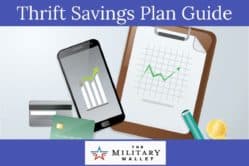The Thrift Savings Plan is one of the best tools military members have to prepare for retirement. Similar to a civilian 401k plan, the Thrift Savings Plan is an employer-sponsored retirement plan which allows participants to save money for retirement directly from their paycheck. The added benefit is the money you contribute isn’t taxed in the year you contribute, and it can grow tax-free until you reach retirement age and make withdrawals.
Because of the many benefits the Thrift Savings Plan provides, many military members want to continue using it when they leave the service. The good news is you get to take the money and tax benefits with you when you leave the military. But many service members want to know if they can continue contributing to your military TSP plan after they leave the service. Unfortunately, it isn’t allowed.
Table of Contents
You Can No Longer Contribute to the TSP When You Leave the Military

Once you leave the military, you can no longer make contributions to your military TSP account.
You may, however, be able to make contributions to a different Thrift Savings Plan account if you get hired by a government agency that offers it. My wife did this after she separated from the military and later worked as a civil servant.
The caveat is that you have to open a new Thrift Savings Plan when you start your civil service job, which means you will have two Thrift Savings Plan accounts. The good news is that civil servants are automatically enrolled in the TSP.
If you work for the government and open a new TSP account, you will have the option of rolling your military TSP into your civil service TSP. This may be a good idea for simplifying your bookkeeping (fewer accounts is almost always better since it takes less work to manage them). However, you should be aware that doing so may take away one of the biggest benefits of the military TSP – tax-exempt contributions.
If you made contributions while in a tax-free zone, your contributions would be considered tax-exempt, and you will be able to withdraw those contributions tax-free when you reach retirement age. This is a huge benefit many veterans and military members are not aware of. So if you have any tax-exempt contributions to your TSP, I don’t recommend rolling them into a civil service TSP, or another employer-sponsored retirement account unless you can keep these contributions in a tax-exempt status (which isn’t likely).
You may, however, be able to roll your TSP into an IRA and preserve the tax-exempt contributions (the tax-exempt portion goes into a Roth IRA, and the other portion goes into a Traditional IRA; get professional help if needed – you want to get this right the first time!).
Other Retirement Plan Options
Just because you won’t be able to contribute further to your TSP account doesn’t mean you should stop saving for retirement. It is almost always a good idea to save for retirement. Here are some places you can invest if you plan on saving more for retirement:
Civil Service TSP
The TSP for civil service workers is virtually the same as the plan for military members. However, most civil servants are eligible for employer matching, which is where the government will make contributions to your account for you. The government will give you a small contribution just for participating. Then they will match your contributions up to a certain percentage. It is highly recommended to take advantage of this plan as the employer match is essentially free money and part of your employer benefits.
401k plan or another employer-sponsored retirement plan
There are several employer-sponsored retirement plans similar to the Thrift Savings Plan, including 401k plans, 401b plans, and several others. Like the civil service TSP, some companies offer employer matching contributions, which can turbo-charge your retirement savings.
Traditional or Roth IRA
One of the benefits of investing in IRAs is that they are open to anyone who has earned income – even if you are participating in an employer-sponsored retirement plan. It is possible to have multiple retirement accounts, as long as you don’t exceed the relevant contribution limits in any given year. You can also have IRA accounts with multiple IRA providers, again, as long as you don’t exceed IRA contribution limits. For ease of bookkeeping, however, it is much easier to maintain your accounts in as few places as possible.
Self-employed retirement accounts
If you have your own business, you may be able to open a self-employed retirement account, such as a Solo 401k, SEP IRA, Keough, or another self-employed retirement account. If you are self-employed, I strongly recommend meeting with an accountant to help you determine which business structure and retirement plan option are best for your needs (sometimes your business structure will determine which type of self-employed retirement plan account you are eligible for).
Important note about contribution limits:
Thrift Savings Plan contribution limits are the same as other employer-sponsored retirement plans such as the civilian TSP, 401k plans, 401b, plans, etc., and the limits apply across all accounts. This is good to know if you contribute to the military TSP and another employer-sponsored retirement plan in the same year.
Keep Saving for Retirement
Even if you are receiving a military pension, it is a good idea to continue saving for retirement. People are living longer now than ever before, and the cost of living will only continue to rise due to inflation. You may also find that saving for retirement will give you tax breaks now or in the future and potentially give you various ways to manage your investments and, ultimately, your estate.



Comments:
About the comments on this site:
These responses are not provided or commissioned by the bank advertiser. Responses have not been reviewed, approved or otherwise endorsed by the bank advertiser. It is not the bank advertiser’s responsibility to ensure all posts and/or questions are answered.
Chris Miller says
I am retiring from the Army this year. After which I will be working and contributing to a Roth IRA through Fidelity over the next 25 years. Can I roll that IRA over into my TSP account every couple years to keep all my eggs in one basket?
mistake says
I intended to do something good, but in retrospect I think I made a mistake. Here is my not too short story:
My wife and I both worked for DoD as federal employees for several years. In 1998, due to a re-organization, VSIPs were being offered to anyone who was willing to separate from civil service. My wife was 39, signed up for a VSIP and it was granted; she separated from civil service and became a stay-home mom. When my wife separated, she had completed 13-years of federal service and had been a TSP contributor during her working years. In her working years, the Traditional TSP is all that existed. My wife left her Traditional TSP account in place, earning whatever little it was earning without making further contributions. I continued working as a civil servant, and I have always been a TSP contributor.
Fourteen years later, while continuing to work for DoD as a civil servant, I learned that since I am still working, I can contribute into my non-working wife’s TSP account, just not directly. (Worthy of mentioning is that TSP now offers Roth TSP accounts, whereas before the only choice we all had was the traditional type.) So, one day I opened a Roth IRA for my wife online and put in the maximum amount allowed. Days later my wife went to the same bank with a filled-out Form TSP-60 and submitted it. The purpose of this was to rollover the funds from the Roth IRA into her TSP account. Soon we found out that TSP did not accept the bank’s Roth IRA because my wife’s TSP is of the traditional type. Immediately, my wife returned to the bank and requested that the Roth IRA that I had funded for her be converted to Traditional IRA. Since the Roth IRA had been opened just days before, the bank reclassified it as a Traditional IRA. My wife revised the Form TSP-60 and resubmitted it to the bank to rollover the now Traditional IRA into TSP. The transaction went through and TSP acknowledged receipt of the funds and their allocation.
I repeated this “mistake” five times at $6,500 dollars each time. $25k later I am asking myself: why did I use already-taxed dollars and put them into a Traditional TSP? This question did not dawn on me before. What will happen when my wife draws those funds? She will be taxed on the entire amount, I am sure.
1st question: Is this an irreversible mistake? If not, how can I correct it?
2nd question: what should I have done instead?
Note: my wife will probably not begin drawing from the TSP until, maybe, year 2020 or later.
Ryan Guina says
It sounds to me like you opened a Traditional IRA, then rolled it into the Thrift Savings Plan. There is nothing inherently wrong with this, as the TSP has some great investment options and extremely low management fees. It’s also nice to be able to control all your investments in one place. As for contributing already taxed funds to the Tsp – my question is this: did you deduct the Traditional IRA contributions on your taxes? If so, then you would have received the same tax deductions that would have been available in the TSP (Traditional IRAs count as a tax deduction in the year the contribution is made; funds are taxed when withdrawn).
Did you make a mistake? You’ll need to go back and look at your previous tax returns. If you didn’t claim your Traditional IRA contribution, then you may need to file an amended ta return. My recommendation is to visit a tax professional and go over your situation. You may find and be able to correct a large mistake (either in your favor or against). Or you may find that you did everything correctly the first time. Either way, you will have the pace of mind that comes with knowing the situation is resolved. I wish you the best!
Hope to Retire says
I plan on doing my 20 (or more!) and I have a question. Can I contribute to TSP when I am drawing a pension? More importantly, if I take a loan out from TSP, can I repay it using pension dollars?
Ryan Guina says
Hope to Retire, Thank you for your question. TSP contributions can only be made through payroll deductions, whether you are working for the military or civil service. Because of this, you can no longer contribute to the TSP after you have separated from the military (or from the civil service).
You can roll money into the TSP by transferring another 401k, IRA, or similar retirement account into your TSP account, but you can’t add new money once you are no longer working for the government.
You also cannot repay a loan after you retire. Loans can only be taken while you are still eligible to contribute to the TSP. And here is the most important thing to know about taking out a loan: it is due the day you leave the service. So if you take out a loan right before you retire (or otherwise separate), it is due at that time. If you do not have the funds to repay your loan, the IRS will consider it a withdrawal and you will owe taxes and a 10% early withdrawal penalty if you are under age 50. In other words, TSP loans are generally not a good idea!
I hope this points you in the right direction.
confussed says
can you please explain exactly what happens in the situation where you take out a loan from your TSP right before you retire. I always thought that borrowing from your TSP was just borrowing money from yourself. if this is the case aren’t I just repaying the loan and then they are giving it right back to me as my final TSP withdrawal.
Ryan Guina says
Hello confussed, I would strongly recommend against taking out a TSP loan right before you retire, because loans from retirement accounts are due in full within 60 days of the time your employment terminates. Failing to repay the loan in full by that time will usually result in taxes and early withdrawal penalties (if under age 59.5) of the amount not repaid. The early withdrawal penalty is 10% of the amount withdrawn, and taxes are at your marginal income rate. This is due to the IRS immediately. So you would end up losing a large portion of the amount of money you withdraw in the form of a loan, potentially putting you in a worse financial position. Here are more details about TSP loans, and 401k loans (which have very similar rules).
In short, unless it is an emergency, it’s almost certainly not a good idea to take out a TSP loan right before you retire. I would look into other methods of obtaining the necessary funds, or delaying any large purchases until they can be made in a more cost-effective manner. This may be a reasonable option if you need the money for an emergency, such as medical bills, emergency house repairs, etc. You may consider visiting with a financial planner for more specific advice based on your specific situation.
Retired says
About what you said in the article about, Can I contribute to the TSP When I Leave the Military?
I understand that you can not contribute to TSP from your new job, but there are ways to put money into your TSP.
You can roll over an Traditional IRA you have or an 401K from a old employer you no longer work for.
Ryan Guina says
Retired – this is correct, you can do a rollover into your TSP, but you cannot make new contributions after you have left the military or federal service. Rollovers aren’t considered contributions though, so it’s important to note the difference.
j says
Just wanted to correct you on your annuity option in your post…Indexed annuities are not loaded with fees, and are not complicated to understand..Most CFP’s don’t understand how they work…you can get a lifetime income rider that gets anywhere from 5-10% interest (some have 6.5% compound)on that income bucket..for a nominal fee of .4-.65 annually..and that can cancel anytime. CFP’s often talk about caps and surrender fees etc…these programs consistently out perform the s and p because they have what is called “annual reset”..where securities have to pick up from their losses…indexed annuities stay level..their principal is 100% protected..clients love them because they get educated properly. thx